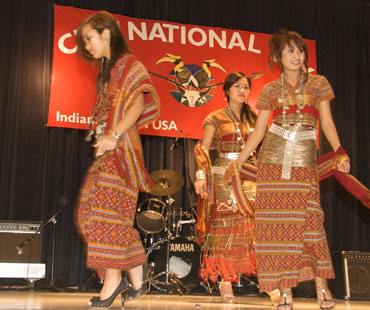Despite grinding poverty and an ongoing food crisis, the ethnic people of Chin State celebrated their national day for the first time in 30 years on February 20.
 Ceremonies and events were held in state capital Hakha and other towns across the region, as well as in Yangon and Naypyitaw.
Ceremonies and events were held in state capital Hakha and other towns across the region, as well as in Yangon and Naypyitaw.
Writing for Chinland Guardian, Van Biak Thang said, “Celebrations of the 65th Chin National Day in Chin State brought a renewed ray of hope for the Chin people who had faced restrictions to hold their historic day in Burma for decades.”
The Hakha ceremony was jointly organized by the Chin National Front (CNF) and the Chin State government. Festivities included traditional sports, song and dance, and was attended by many exiled Chins who were returning to their homeland for the first time in years, if not decades.
Speaking on behalf of the CNF, the 2007 Martin Luther King award winner Dr. Lian Hmung Sakhong said, “Commemorating Chin National Day today re-establishes the 65-year struggle of the Chin as a nationalist movement.”
Stressing that the ceremony is inseparably connected with the pro-democracy cause, the renowned Chin academic continued: “Whenever anti-democracy forces were in power, the celebration of Chin National Day was banned. Just as democracy was suppressed, so was permission to observe our national day.”
Chin National Day has its roots in the Falam Conference of February 18-20, 1948, when 5,000 Chin representatives voted to overturn their traditional feudal system in favor of a democratic vote to elect local officials.
The ceremony was banned under the reign of the military junta in Myanmar, but a meeting in December between the CNF and the Union government re-established February 20 as Chin National Day and an official state holiday.
Wednesday’s festivities in Hakha were attended by Union Ministers Soe Thein and Win Tun, Chin State Chief Minister Pu Hung Ngai and other state ministers, Chin MPs, and members of the CNF who in January 2012 signed a ceasefire agreement with the central government after 23 years of resistance.
In December, the CNF went a step further in signing a 27-point plan with a government delegation in Yangon, which encompassed education, health, human rights, resources and various other social and economic issues, as well as the re-establishment of Chin National Day.
In Naypyitaw, a ceremony to mark the occasion was attended by opposition leader Aung San Suu Kyi and Lower House speaker Thura Shwe Mann.
President Thein Sein visited the Chin State capital on Saturday, February 16, with a delegation that included the ministers of health, education, forestry, immigration, and science and technology.
On Sunday, the Myanmar President announced that the central government will support Chin State’s infrastructure of roads, and will ensure supplies of water and electricity.
Speaking to Mizzima reporter Kun Chan, the Chin State Agricultural Minister Van Thawng said that Thein Sein authorized the State government to install a 66 kW power grid, and to improve roads such as the Hakha – Ganggaw (Magway Region) Highway, and the Hakha – Kalay (Sagaing Region) Highway.
“Thein Sein said that the Chin State government has responsibility to fulfill the needs of people in the area. He said the local authorities have to do whatever they can, and that for matters beyond their capability, they can request help from the central government,” said Van Thawng.
The President also gave directions on state education and for the re-opening of the Falam Agricultural Institute.
But Chin State has yet to recover from the 2007-09 “mautum, a catastrophic event meaning “bamboo death”, which occurs in Chin State and the surrounding regions every 48 years when the flowering of a bamboo plant causes an intense rat infestation. The rats subsequently eat the bamboo plants, reproduce exponentially and attack farmers’ crops.
A survey carried out between January 7 and February 10 by State MP Pu Lal Maung Cung, who is a CNF member, concluded that severe food shortages were common across the state, and that cases of starvation were reported.
“About 22 villages in Than Tlang Township, including Vailam, Zanak and Vanzangtlang areas, were surveyed by Pu Lal Maung Cung,” wrote Khonumthung News on February 15. “Zanak tlang area is the most affected by starvation among the three areas in Than Tlang, so the government and Hluttaw representatives are obliged to solve the problem here first, said Pu Lal Maung Cung.”
Food shortages and water supply problems were reported in other parts of the region.
The Chin ethnic group makes up the majority of the mountainous state's 500,000 people, some 70 percent of whom are Christians. Sparsely populated and officially the poorest state in the country, the region remains one of the least developed areas in Myanmar and has the highest unemployment rate at 73 percent.



